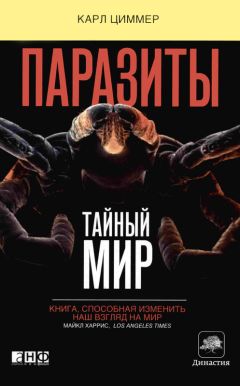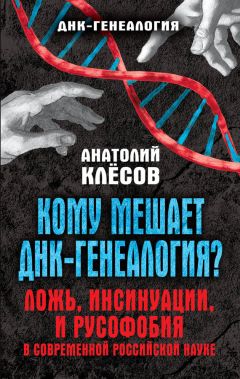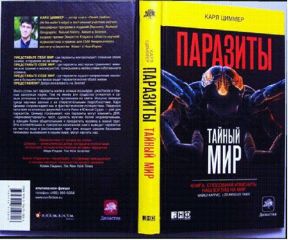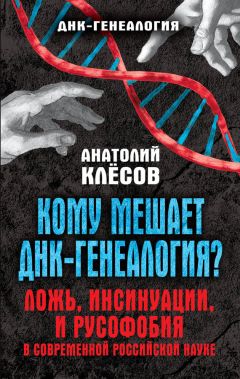Карл Циммер - Микрокосм. E. coli и новая наука о жизни
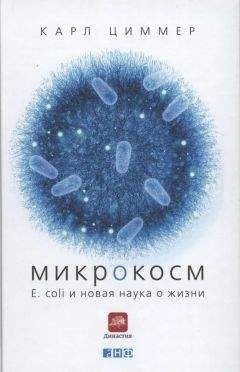
Помощь проекту
Микрокосм. E. coli и новая наука о жизни читать книгу онлайн
Chang, D. E., D. J. Smalley, and T. Conway. 2002. Gene expression profiling of Escherichia coli growth transitions: An expanded stringent response model. Mol Microbiol 45 (2):289–306.
Chang, М. С., and J. D. Keasling. 2006. Production of isoprenoid pharmaceuticals by engineered microbes. Nat Chem Biol 2
(12):674—81.
Chargaff, E., and F. R. Simring. 1976. On the dangers of genetic meddling. Science 192(4243):938.
Chen, S. L., С. S. Hung, J. Xu, C. S. Reigstad, V. Magrini, A. Sabo, D. Blasiar, T. Bieri, R. R. Meyer, P. Ozersky, J. R. Armstrong, R. S. Fulton, J. P. Latreille, J. Spieth, T. M. Hooton, E. R. Mardis, S. J. Hultgren, and J. I. Gordon. 2006. Identification of genes subject to positive selection in uropathogenic strains of Escherichia eoli: A comparative genomics approach. Proc Natl Acad Sei USA 103 (15):5977—82.
Chong, Jia‑Rui. 2006.13th century text hides words of Archimedes. Los Angeles Times, December 26,2006.
Chou, C. P. 2007. Engineering cell physiology to enhance recombinant protein produc- tion in Escherichia eoli. Appl Microbiol Biotechnol, in press.
Ciccarelli, Francesca D., Tobias Doerks, Christian von Mering, Christopher J. Creevey, Berend Snel, and Peer Bork. 2006. Toward automatic reconstruction of a highly resolved tree of life. Science 311 (5765):1283-87.
Cirz, R. T., J. K. Chin, D. R. Andes, V. de Crйcy‑Lagard, W. A. Craig, and F. E. Romes- berg. 2005. Inhibition of mutation and combating the evolution of antibiotic resistance. PLoS Biol 3 (6):el76.
Clarke, T. 2001. The stowaways. Nature 413 (6853):247-48.
Clinton, W. J. 2000. Speech by President on Completion of First Survey of En- tire Human Genome, http://www.clintonpresidentialcenter.org; accessed Octo- ber 24,2007.
Cosentino Lagomarsino, M., P. Jona, В. Bassetti, and H. Isambert. 2007. Hierarchy and feedback in the evolution of the Escherichia eoli transcription network. Proc Natl Acad Sei USA 104 (13):5516-20.
Crabb, W. D., and J. K. Shetty. 1999. Commodity scale production of sugars from starches. Curr Opin Microbiol 2 (3):252—56.
Crozat, E., N. Philippe, R. E. Lenski, J. Geiselmann, and D. Schneider.
2005. Long‑term experimental evolution in Escherichia coli. XII. DNA topology as a key target of selection. Genetics 169 (2):523—32.
Csete, M., and J. Doyle. 2004. Bow ties, metabolism and disease. Trends Biotechnol 22 (9):446-50.
Davis, Rowland H. 2003. The microbial models of molecular biology: From genes to genomes. New York: Oxford University Press.
Delbrьck, M. 1954. On the replication of desoxyribonucleic acid (DNA). Proc Natl Acad Sei USA 40:783-88.
—. 1969. Nobel lecture, http://nobelprize.org/nobel prizes/medicine/laureates /1969 / delbruck‑lecture. html.
Demerec, M. 1948. Origin of bacterial resistance to antibiotics./ Bacteriol 56 (l):63–74.
Denamur, E., 0. Tenaillon, C. Deschamps, D. Skurnik, E. Ronco, J. L. Gaillard, В. Pi- card, C. Branger, and I. Matic. 2005. Intermediate mutation frequencies favor evo- lution of multidrug resistance in Escherichia eoli. Genetics 171 (2):825-27.
Dethlefsen, L., P. В. Eckburg, E. M. Bik, and D. A. Relman. 2006. Assembly of the human intestinal microbiota. Trends Ecol Evol 21 (9):517—23.
Dick, Steven J. 1998. Life on other worlds: The twentieth‑century extraterrestrial life debate. New York: Cambridge University Press.
Dick, Steven J., and James Edgar Strick. 2004. The living universe: NASA and the devel- opment of astrobiology. New Brunswick, N. J.: Rutgers University Press.
Dolman, Claude E. 1970. Theodor Escherich. In Dictionary of scientific biography; ed. C. C. Gillispie. New York: Scribner.
Domka, J., J. Lee, T. Bansal, and Т. К. Wood. 2007. Temporal gene- expression in Escherichia coli K-12 biofilms. Environ Microbiol 9
(2):332-46.
Doolittle, W. F. 2000. Uprooting the tree of life. Sei Am 282 (2):90–95.
Doyle, J., D. L. Alderson, L. Li, S. Low, M. Roughan, S. Shalunov, R. Tanaka, and W. Willinger. 2005. The “robust yet fragile” nature of the Internet. Proc Natl Acad Sei USA 102 (41):14497—502.
Doyle, J., and M. Csete. 2005. Motifs, control, and stability. PLoS Bi'o/3 (ll):e392.
Dutton, Diana Barbara, Thomas A. Preston, and Nancy E. Pfund. 1988. Worse than the disease: Pitfalls of medical progress. New York: Cambridge University Press.
Echols, Harrison. 2001. Operators and promoters: The story of molecular biology and its creators. Ed. Carol Gross. Berkeley: University of California Press.
Elena, S. F., and R. E. Lenski. 2003. Evolution experiments with microorganisms: The dynamics and genetic bases of adaptation. Nat Rev Genet4 (6):457-69.
Elf, J., G. W. Li, and X. S. Xie. 2007. Probing transcription factor dynamics at the single- molecule level in a living cell. Science 316 (5828):1191—94.
Elliott, E. J., and R. M. Robins‑Browne. 2005. Hemolytic uremic syndrome. Curr Probl Pediatr Adolesc Health Care 35 (8):310-30.
Elowitz, М. В., and S. Leibler. 2000. A synthetic oscillatory network of transcriptional regulators. Nature 403 (6767):335-38.
Elowitz, М. B., A. J. Levine, E. D. Siggia, and P. S. Swain. 2002. Stochastic gene expres- sion in a single cell. Science 297 (5584):1183-86.
Endy, D. 2005. Foundations for engineering biology. Nature 438 (7067):449-53.
Escherich, T. 1989. The intestinal bacteria of the neonate and breast‑fed infant. 1885. Rev Infect Dis 11 (2):352—56.
ETC Group. 2006. Global coalition sounds the alarm on synthetic biology, demands oversight and societal debate. Press release. http://www.etcgroup.0rg/upload/publication/8/Ol / nr_synthetic_ bio_19th_may_2006.pdf.
Evans, P. D., N. Mekel‑Bobrov, E. J. Vallender, R. R. Hudson, and
B. T. Lahn. 2006.
Evidence that the adaptive allele of the brain size gene microcephalin introgressed into Homo sapiens from an archaic Homo lineage. Proc Natl Acad Sei USA 103 (48):18178-83.
Favier, C. F., E. E. Vaughan, W. M. De Vos, and A. D. Akkermans. 2002. Molecular mon- itoring of succession of bacterial communities in human neonates. Appl Environ Microbiol 68 (l):219-26.
Feist, Adam M., Christopher S. Henry, Jennifer L. Reed, Markus Krummenacker, Andrew R Joyce, Peter D. Karp, Linda J. Broadbelt, Vassily Hatzimanikatis, and Bernhard O. Palsson 2007. A genome‑scale metabolic reconstruction for Escher- ichia coli K-12 MG1655 that accounts for 1260 ORFs and thermodynamic informa- tion. Mol SystBiol 3:121.
Ferens, W. A., R. Cobbold, and C. J. Hovde. 2006. Intestinal Shiga toxin — producing Escherichia coli bacteria mitigate bovine leukemia virus infection in experimentally infected sheep. Infect Immun 74 (5):2906—16.
Forster, A. C., and G. M. Church. 2006. Towards synthesis of a minimal cell. Mol SystBiol 2:45.
Foster, J. W. 2004. Escherichia coli acid resistance: Tales of an amateur acidophile. NatRev Microbiol 2 (ll):898–907.
Foster, K. R., К. Parkinson, and C. R. Thompson. 2007. What can microbial genetics teach sociobiology? Trends Genet 23 (2):74–80.
Francino, M. P. 2005. An adaptive radiation model for the origin of new gene func- tions. Nat Genet 37 (6):573-77.
Fricker, E. J., M. Spigelman, and C. R. Fricker. 1997. The detection of Escherichia coli
DNA in the ancient remains of Lindow Man using the polymerase chain reaction. Lett Appl Microbiol 24 (5):351—54.
Friedmann, H. C. 2004. From Butyribacterium to E. coli: An essay on unity in biochemistry. PerspectBiol Med 47 (1):47–66.
Frost, L. S., R. Leplae, A. O. Summers, and A. Toussaint. 2005. Mobile genetic elements: The agents of open source evolution. Nat Rev Microbiol 3 (9):722-32.
Gamage, S. D., A.К. Patton, J. F. Hanson, and A. A. Weiss. 2004. Diversity and host range of Shiga toxin — encoding phage. Infect Immun 72 (12):7131—39.
Gamag e, S. D., A. K. Patton, J. E. Str asser, C. L. Chalk, and A. A. Weiss.
2006. Commensal bacteria influence Escherichia eoli 0157: H7 persistence and Shiga toxin produc- tion in the mouse intestine. Infect Immun 74 (3):1977-83.
Gamage, S. D., J. E. Strasser, C. L. Chalk, and A. A. Weiss. 2003. Nonpathogenic Escherichia eoli can contribute to the production of Shiga toxin. Infect Immun 71 (6):3107—15.
Gardner, A., S. A. West, and A. Buckling. 2004. Bacteriocins, spite and virulence. ProcBiol Sei 271 (1547):1529—35.
Gardner, T. S., C. R. Cantor, and J. J. Collins. 2000. Construction of a genetic toggle switch in Escherichia eoli. Nature 403 (6767):339-42.
Ge, F., L. S. Wang, and J. Kim. 2005. The cobweb of life revealed by genome‑scale esti- mates of horizontal gene transfer. PLoS Biol
3 (10):e316.
Gelman, S. A. 2004. Psychological essentialism in children. Trends Cogn Sei 8 (9):404-9.
George, R. P., and A. Gomez‑Lobo. 2005. The moral status of the human embryo. PerspectBiol Med 48 (2):201-10.
Gesteland, Raymond F., Thomas Cech, and John F. Atkins. 2006. The RNA world: The nature of modern RNA suggests a prebiotic RNA. 3rd ed. Cold Spring Harbor Monograph Series 43. Cold Spring Harbor, N. Y.: Cold Spring Harbor Laboratory Press. Ghannoum, Mahmoud A., and George A. O’Toole. 2004. Microbial biofilms. Washington, D. C.: ASM Press.
Gladman, B., L. Dones, H. F. Levison, andJ. A. Burns. 2005. Impact seeding and reseed- ing in the inner solar system. Astrobiology 5 (4):483-96.
Goehring, N. W., and J. Beckwith. 2005. Diverse paths to midcell: Assembly of the bacterial cell division machinery. Curr Biol 15
(13):R514-26.
Gorvel, J. P. 2006. Microbiology: Bacterial bushwacking through a microtubule jungle. Science 314 (5801):931—32.
Gould, Stephen Jay. 1989. Wonderful life: The Burgess Shale and the nature of history. New York: W. W. Norton.
Graham, J. P., J. J. Boland, and E. Silbergeld. 2007. Growth‑promoting antibiotics in food animal production: An economic analysis. Public Health Reports 122 (l):79–87. Gray, C. H., and E. L. Tatum. 1944. X‑ray induced growth factor requirements in bacteria. Proc Natl Acad Sei USA 30 (12):404-10.
Haldane, J. B. S. 1923. Daedalus; or, Science and the future: A paper read to the Heretics,
Cambridge, on February 4 th, 1 9 23. http://www.cscs.umich.edu/~crshalizi/Daedalus.html; accessed October 24,2007.
Hall, Stephen S. 2002. Invisible frontiers: The race to synthesize a human gene. New York: Oxford University Press.
Harold, F. M. 2005. Molecules into cells: Specifying spatial architecture. Microbiol MolBiol Rev 69 (4):544-64.
Hartwig, Mark. 2002. Whose comfortable myth? Focus on the Family, June 2002.
Heitkamp, M. A., J. F. Kane, P. J. Morris, M. Bianchini, M. D. Hale, and G. Bogosian. 1993. Fate in sewage of a recombinant Escherichia coli K-12 strain used in the commercial production of bovine somatotropin./Ind Microbiol 11 (4):243-52.
Hejnova, J., U. Dobrindt, R. Nemcova, C. Rusniok, A. Bomba, L. Frangeul, J. Hacker, P. Glaser, P. Sebo, and C. Buchrieser. 2005. Characterization of the flexible genome complement of the commensal Escherichia coli strain A0 34/86 (083: K24: H31). Microbiology 151 (pt. 2):385-98.
Herring, C. D., A. Raghunathan, C. Hцnisch, T. Patel, M. K. Applebee,
A. R. Joyce, T. J. Albert, F. R. Blattner, D. van den Boom, C. R. Cantor, and
B. O. Palsson. 2006. Comparative genome sequencing of Escherichia coli allows observation of bacterial evo- lution on a laboratory timescale. Nat Genet 38 (12):1406—12.
Hershey, A. D., and M. Chase. 1952. Independent functions of viral protein and nucleic acid in growth of bacteriophage. J Gen Physiol 36 (1):39–56.
Higgins, Norman Patrick. 2005. The bacterial chromosome. Washington, D. C.: ASM Press.
Holmes, Frederick Lawrence. 2001. Meselson, Stahl, and the replication ofDNA: A history of the “most beautiful experiment in biology.”New Haven: Yale University Press.
Hou, Shaobin, Jimmy H. Saw, Kit Shan Lee, Tracey A. Freitas, Claude Belisle, Yutaka Kawarabayasi, Stuart P. Donachie, Alla Pikina, Michael Y. Galperin, Eugene V. Koonin, Kira S. Makarova, Marina V. Omelchenko, Alexander Sorokin, Yuri I. Wolf, Qing X. Li, Young Soo Keum, Sonia Campbell, Judith Denery, Shin‑Ichi Aizawa, Satoshi Shibata, Alexander Malahoff, and Maqsudul Alam. 2004. Genome sequence of the deep‑seaproteobacterium Idiomarina loihiensis reveals amino acid fermen- tation as a source of carbon and energy. Proc Natl Acad Sei USA 101 (52):18036-41.
Humes, Edward. 2007. Monkey girl: Evolution, education, religion, and the battle for America’s soul. New York: Ecco.
Inoue, T., R. Shingaki, S. Hirose, K. Waki, H. Mori, and K. Fukui. 2007. Genome‑wide screening of genes required for swarming motility in Escherichia coli K-12.JBacte- riol 189 (3):950—57.
Jackson, David Archer, and Stephen P. Stich. 1979. The recombinant DNA debate. Englewood Cliffs, N. J.: Prentice‑Hall.
Jacob, Franзois. 1995. The statue within: An autobiography. Cold Spring Harbor, N. Y.: Cold Spring Harbor Laboratory Press.
Jennison, A. V., and N. K. Verma. 2004. Shigella flexneri infection: Pathogenesis and vaccine development. FEMS Microbiol Rev 28 (1):43–58.
